ENGM123 Project: Green Engineering Impacts on UK Emission Reduction
VerifiedAdded on 2023/07/24
|12
|2849
|362
Project
AI Summary
This project research plan investigates the impact of green engineering solutions on emission reduction within the UK construction management sector. It examines the potential of green building materials, renewable energy sources, and sustainable construction techniques, including Building Information Modeling (BIM) and the Internet of Things (IoT), to mitigate emissions and reduce waste. The research employs a mixed-methods approach, combining literature review, interviews with industry experts, site visits, and potentially surveys to gather both qualitative and quantitative data. The study aims to evaluate the specific impacts of green technology, identify successful building technologies for waste and emission reduction, and assess the cost-saving potential of BIM and IoT integration, ultimately providing strategies and guidelines for maximizing the benefits of green technology in construction projects. This document is available on Desklib, a platform providing study tools and resources for students.
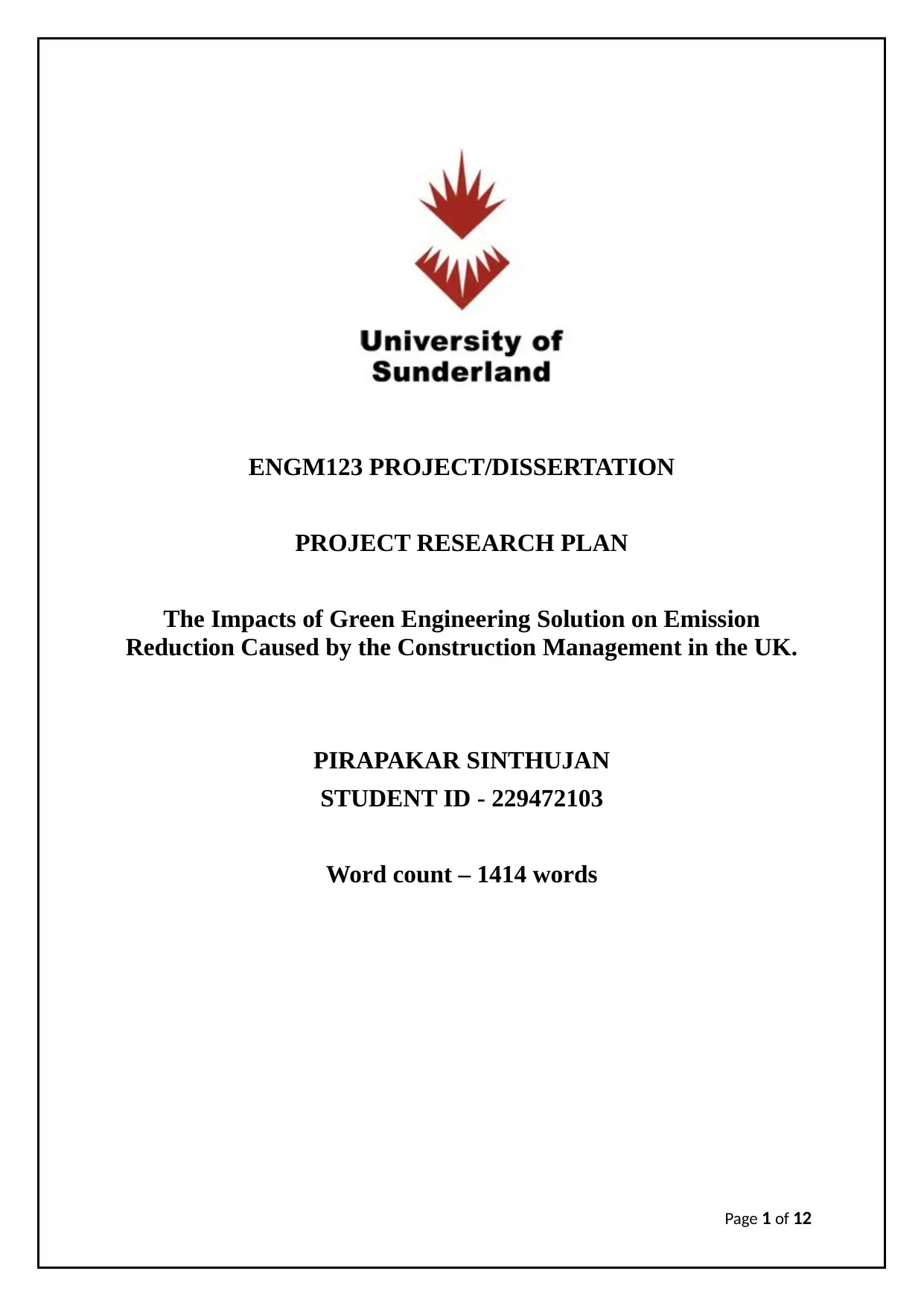
ENGM123 PROJECT/DISSERTATION
PROJECT RESEARCH PLAN
The Impacts of Green Engineering Solution on Emission
Reduction Caused by the Construction Management in the UK.
PIRAPAKAR SINTHUJAN
STUDENT ID - 229472103
Word count – 1414 words
Page 1 of 12
PROJECT RESEARCH PLAN
The Impacts of Green Engineering Solution on Emission
Reduction Caused by the Construction Management in the UK.
PIRAPAKAR SINTHUJAN
STUDENT ID - 229472103
Word count – 1414 words
Page 1 of 12
Paraphrase This Document
Need a fresh take? Get an instant paraphrase of this document with our AI Paraphraser
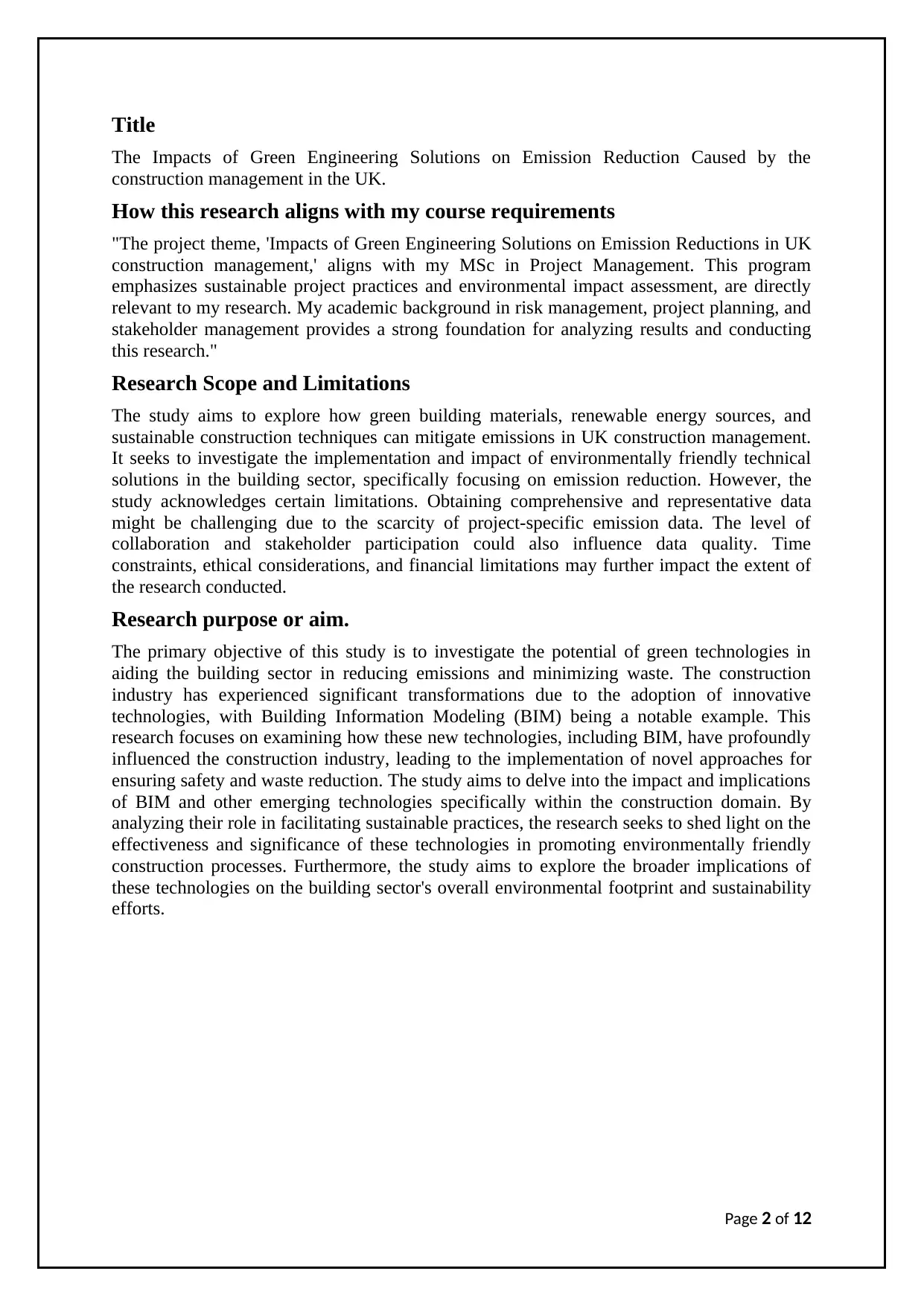
Title
The Impacts of Green Engineering Solutions on Emission Reduction Caused by the
construction management in the UK.
How this research aligns with my course requirements
"The project theme, 'Impacts of Green Engineering Solutions on Emission Reductions in UK
construction management,' aligns with my MSc in Project Management. This program
emphasizes sustainable project practices and environmental impact assessment, are directly
relevant to my research. My academic background in risk management, project planning, and
stakeholder management provides a strong foundation for analyzing results and conducting
this research."
Research Scope and Limitations
The study aims to explore how green building materials, renewable energy sources, and
sustainable construction techniques can mitigate emissions in UK construction management.
It seeks to investigate the implementation and impact of environmentally friendly technical
solutions in the building sector, specifically focusing on emission reduction. However, the
study acknowledges certain limitations. Obtaining comprehensive and representative data
might be challenging due to the scarcity of project-specific emission data. The level of
collaboration and stakeholder participation could also influence data quality. Time
constraints, ethical considerations, and financial limitations may further impact the extent of
the research conducted.
Research purpose or aim.
The primary objective of this study is to investigate the potential of green technologies in
aiding the building sector in reducing emissions and minimizing waste. The construction
industry has experienced significant transformations due to the adoption of innovative
technologies, with Building Information Modeling (BIM) being a notable example. This
research focuses on examining how these new technologies, including BIM, have profoundly
influenced the construction industry, leading to the implementation of novel approaches for
ensuring safety and waste reduction. The study aims to delve into the impact and implications
of BIM and other emerging technologies specifically within the construction domain. By
analyzing their role in facilitating sustainable practices, the research seeks to shed light on the
effectiveness and significance of these technologies in promoting environmentally friendly
construction processes. Furthermore, the study aims to explore the broader implications of
these technologies on the building sector's overall environmental footprint and sustainability
efforts.
Page 2 of 12
The Impacts of Green Engineering Solutions on Emission Reduction Caused by the
construction management in the UK.
How this research aligns with my course requirements
"The project theme, 'Impacts of Green Engineering Solutions on Emission Reductions in UK
construction management,' aligns with my MSc in Project Management. This program
emphasizes sustainable project practices and environmental impact assessment, are directly
relevant to my research. My academic background in risk management, project planning, and
stakeholder management provides a strong foundation for analyzing results and conducting
this research."
Research Scope and Limitations
The study aims to explore how green building materials, renewable energy sources, and
sustainable construction techniques can mitigate emissions in UK construction management.
It seeks to investigate the implementation and impact of environmentally friendly technical
solutions in the building sector, specifically focusing on emission reduction. However, the
study acknowledges certain limitations. Obtaining comprehensive and representative data
might be challenging due to the scarcity of project-specific emission data. The level of
collaboration and stakeholder participation could also influence data quality. Time
constraints, ethical considerations, and financial limitations may further impact the extent of
the research conducted.
Research purpose or aim.
The primary objective of this study is to investigate the potential of green technologies in
aiding the building sector in reducing emissions and minimizing waste. The construction
industry has experienced significant transformations due to the adoption of innovative
technologies, with Building Information Modeling (BIM) being a notable example. This
research focuses on examining how these new technologies, including BIM, have profoundly
influenced the construction industry, leading to the implementation of novel approaches for
ensuring safety and waste reduction. The study aims to delve into the impact and implications
of BIM and other emerging technologies specifically within the construction domain. By
analyzing their role in facilitating sustainable practices, the research seeks to shed light on the
effectiveness and significance of these technologies in promoting environmentally friendly
construction processes. Furthermore, the study aims to explore the broader implications of
these technologies on the building sector's overall environmental footprint and sustainability
efforts.
Page 2 of 12
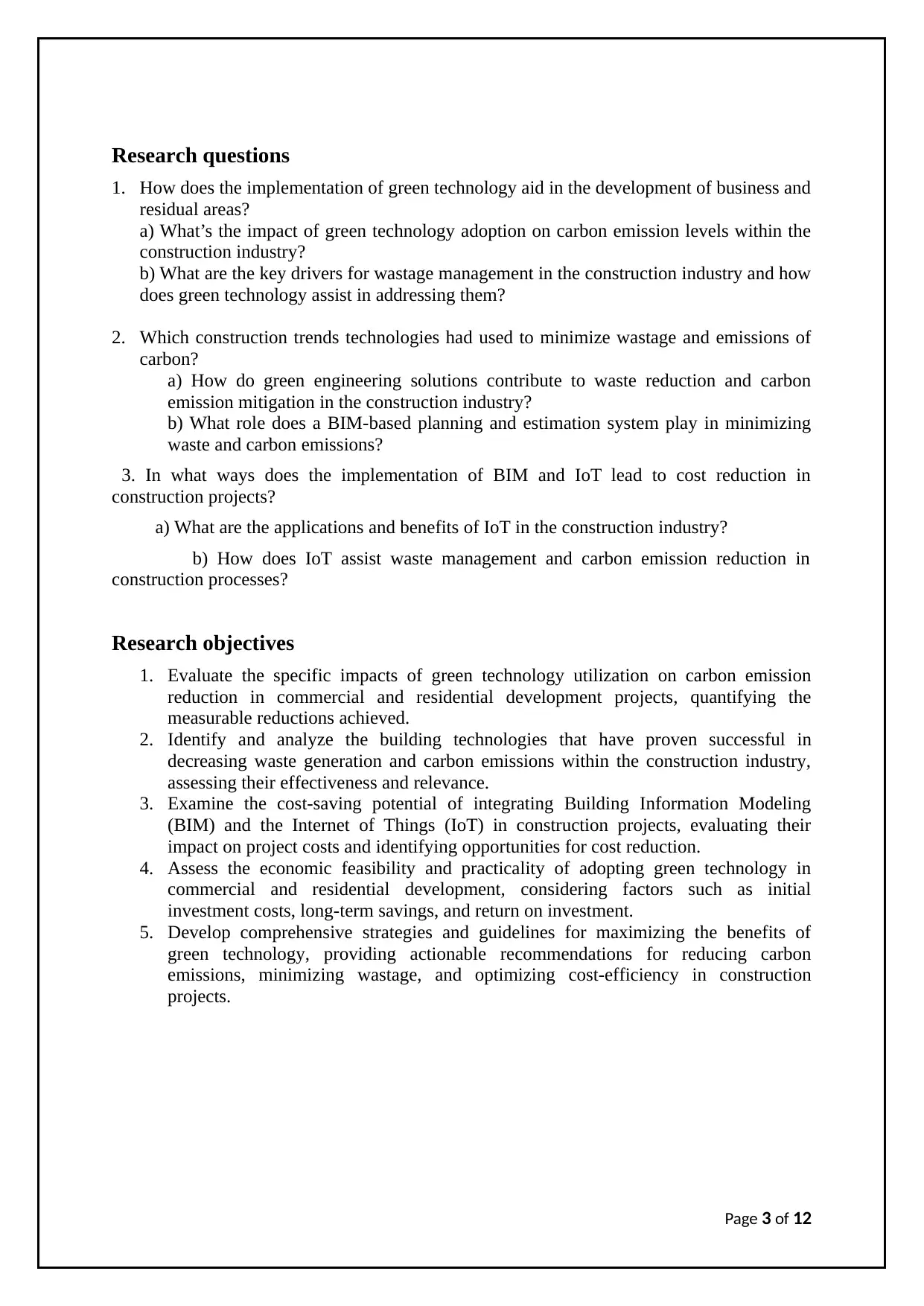
Research questions
1. How does the implementation of green technology aid in the development of business and
residual areas?
a) What’s the impact of green technology adoption on carbon emission levels within the
construction industry?
b) What are the key drivers for wastage management in the construction industry and how
does green technology assist in addressing them?
2. Which construction trends technologies had used to minimize wastage and emissions of
carbon?
a) How do green engineering solutions contribute to waste reduction and carbon
emission mitigation in the construction industry?
b) What role does a BIM-based planning and estimation system play in minimizing
waste and carbon emissions?
3. In what ways does the implementation of BIM and IoT lead to cost reduction in
construction projects?
a) What are the applications and benefits of IoT in the construction industry?
b) How does IoT assist waste management and carbon emission reduction in
construction processes?
Research objectives
1. Evaluate the specific impacts of green technology utilization on carbon emission
reduction in commercial and residential development projects, quantifying the
measurable reductions achieved.
2. Identify and analyze the building technologies that have proven successful in
decreasing waste generation and carbon emissions within the construction industry,
assessing their effectiveness and relevance.
3. Examine the cost-saving potential of integrating Building Information Modeling
(BIM) and the Internet of Things (IoT) in construction projects, evaluating their
impact on project costs and identifying opportunities for cost reduction.
4. Assess the economic feasibility and practicality of adopting green technology in
commercial and residential development, considering factors such as initial
investment costs, long-term savings, and return on investment.
5. Develop comprehensive strategies and guidelines for maximizing the benefits of
green technology, providing actionable recommendations for reducing carbon
emissions, minimizing wastage, and optimizing cost-efficiency in construction
projects.
Page 3 of 12
1. How does the implementation of green technology aid in the development of business and
residual areas?
a) What’s the impact of green technology adoption on carbon emission levels within the
construction industry?
b) What are the key drivers for wastage management in the construction industry and how
does green technology assist in addressing them?
2. Which construction trends technologies had used to minimize wastage and emissions of
carbon?
a) How do green engineering solutions contribute to waste reduction and carbon
emission mitigation in the construction industry?
b) What role does a BIM-based planning and estimation system play in minimizing
waste and carbon emissions?
3. In what ways does the implementation of BIM and IoT lead to cost reduction in
construction projects?
a) What are the applications and benefits of IoT in the construction industry?
b) How does IoT assist waste management and carbon emission reduction in
construction processes?
Research objectives
1. Evaluate the specific impacts of green technology utilization on carbon emission
reduction in commercial and residential development projects, quantifying the
measurable reductions achieved.
2. Identify and analyze the building technologies that have proven successful in
decreasing waste generation and carbon emissions within the construction industry,
assessing their effectiveness and relevance.
3. Examine the cost-saving potential of integrating Building Information Modeling
(BIM) and the Internet of Things (IoT) in construction projects, evaluating their
impact on project costs and identifying opportunities for cost reduction.
4. Assess the economic feasibility and practicality of adopting green technology in
commercial and residential development, considering factors such as initial
investment costs, long-term savings, and return on investment.
5. Develop comprehensive strategies and guidelines for maximizing the benefits of
green technology, providing actionable recommendations for reducing carbon
emissions, minimizing wastage, and optimizing cost-efficiency in construction
projects.
Page 3 of 12
⊘ This is a preview!⊘
Do you want full access?
Subscribe today to unlock all pages.

Trusted by 1+ million students worldwide
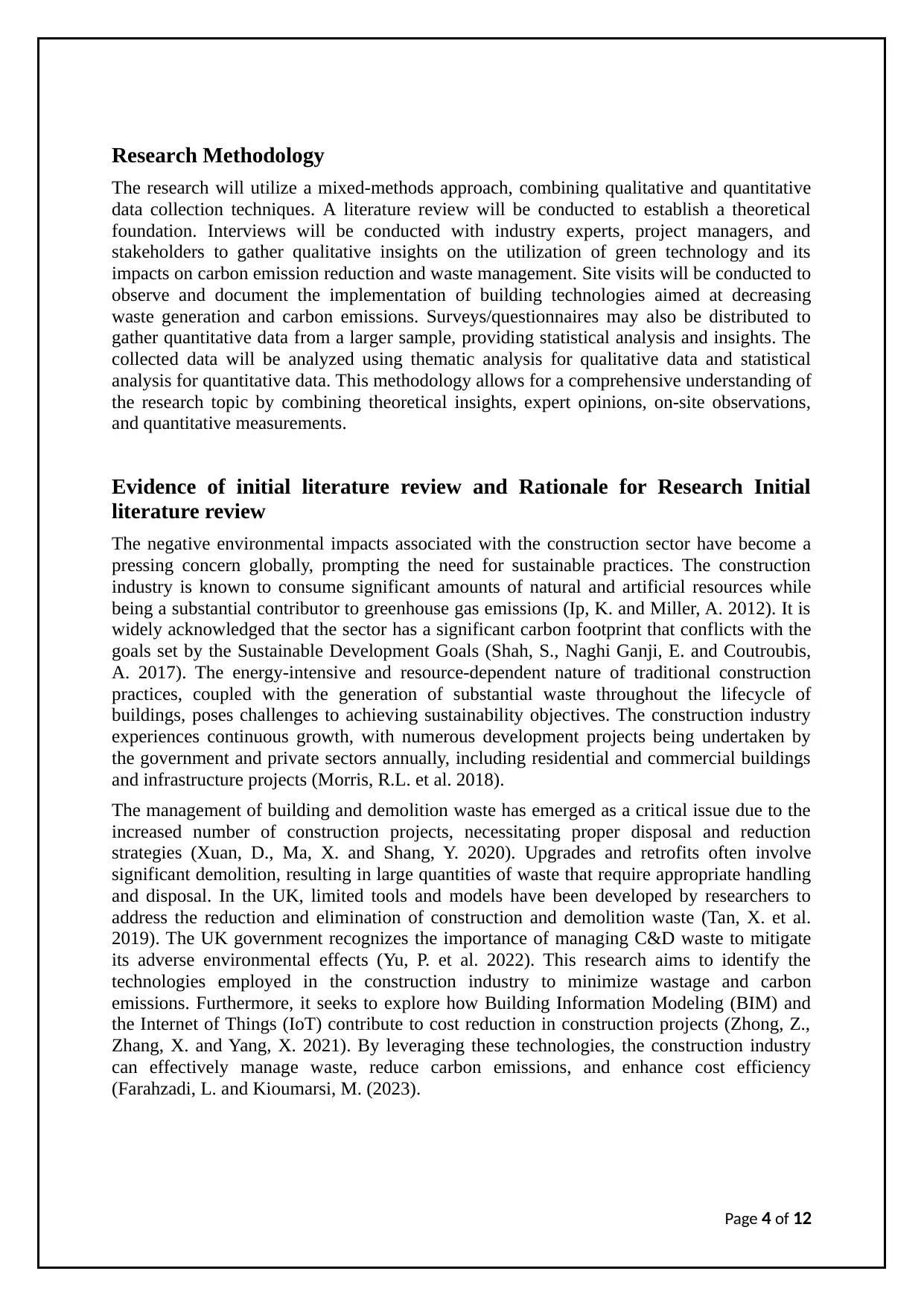
Research Methodology
The research will utilize a mixed-methods approach, combining qualitative and quantitative
data collection techniques. A literature review will be conducted to establish a theoretical
foundation. Interviews will be conducted with industry experts, project managers, and
stakeholders to gather qualitative insights on the utilization of green technology and its
impacts on carbon emission reduction and waste management. Site visits will be conducted to
observe and document the implementation of building technologies aimed at decreasing
waste generation and carbon emissions. Surveys/questionnaires may also be distributed to
gather quantitative data from a larger sample, providing statistical analysis and insights. The
collected data will be analyzed using thematic analysis for qualitative data and statistical
analysis for quantitative data. This methodology allows for a comprehensive understanding of
the research topic by combining theoretical insights, expert opinions, on-site observations,
and quantitative measurements.
Evidence of initial literature review and Rationale for Research Initial
literature review
The negative environmental impacts associated with the construction sector have become a
pressing concern globally, prompting the need for sustainable practices. The construction
industry is known to consume significant amounts of natural and artificial resources while
being a substantial contributor to greenhouse gas emissions (Ip, K. and Miller, A. 2012). It is
widely acknowledged that the sector has a significant carbon footprint that conflicts with the
goals set by the Sustainable Development Goals (Shah, S., Naghi Ganji, E. and Coutroubis,
A. 2017). The energy-intensive and resource-dependent nature of traditional construction
practices, coupled with the generation of substantial waste throughout the lifecycle of
buildings, poses challenges to achieving sustainability objectives. The construction industry
experiences continuous growth, with numerous development projects being undertaken by
the government and private sectors annually, including residential and commercial buildings
and infrastructure projects (Morris, R.L. et al. 2018).
The management of building and demolition waste has emerged as a critical issue due to the
increased number of construction projects, necessitating proper disposal and reduction
strategies (Xuan, D., Ma, X. and Shang, Y. 2020). Upgrades and retrofits often involve
significant demolition, resulting in large quantities of waste that require appropriate handling
and disposal. In the UK, limited tools and models have been developed by researchers to
address the reduction and elimination of construction and demolition waste (Tan, X. et al.
2019). The UK government recognizes the importance of managing C&D waste to mitigate
its adverse environmental effects (Yu, P. et al. 2022). This research aims to identify the
technologies employed in the construction industry to minimize wastage and carbon
emissions. Furthermore, it seeks to explore how Building Information Modeling (BIM) and
the Internet of Things (IoT) contribute to cost reduction in construction projects (Zhong, Z.,
Zhang, X. and Yang, X. 2021). By leveraging these technologies, the construction industry
can effectively manage waste, reduce carbon emissions, and enhance cost efficiency
(Farahzadi, L. and Kioumarsi, M. (2023).
Page 4 of 12
The research will utilize a mixed-methods approach, combining qualitative and quantitative
data collection techniques. A literature review will be conducted to establish a theoretical
foundation. Interviews will be conducted with industry experts, project managers, and
stakeholders to gather qualitative insights on the utilization of green technology and its
impacts on carbon emission reduction and waste management. Site visits will be conducted to
observe and document the implementation of building technologies aimed at decreasing
waste generation and carbon emissions. Surveys/questionnaires may also be distributed to
gather quantitative data from a larger sample, providing statistical analysis and insights. The
collected data will be analyzed using thematic analysis for qualitative data and statistical
analysis for quantitative data. This methodology allows for a comprehensive understanding of
the research topic by combining theoretical insights, expert opinions, on-site observations,
and quantitative measurements.
Evidence of initial literature review and Rationale for Research Initial
literature review
The negative environmental impacts associated with the construction sector have become a
pressing concern globally, prompting the need for sustainable practices. The construction
industry is known to consume significant amounts of natural and artificial resources while
being a substantial contributor to greenhouse gas emissions (Ip, K. and Miller, A. 2012). It is
widely acknowledged that the sector has a significant carbon footprint that conflicts with the
goals set by the Sustainable Development Goals (Shah, S., Naghi Ganji, E. and Coutroubis,
A. 2017). The energy-intensive and resource-dependent nature of traditional construction
practices, coupled with the generation of substantial waste throughout the lifecycle of
buildings, poses challenges to achieving sustainability objectives. The construction industry
experiences continuous growth, with numerous development projects being undertaken by
the government and private sectors annually, including residential and commercial buildings
and infrastructure projects (Morris, R.L. et al. 2018).
The management of building and demolition waste has emerged as a critical issue due to the
increased number of construction projects, necessitating proper disposal and reduction
strategies (Xuan, D., Ma, X. and Shang, Y. 2020). Upgrades and retrofits often involve
significant demolition, resulting in large quantities of waste that require appropriate handling
and disposal. In the UK, limited tools and models have been developed by researchers to
address the reduction and elimination of construction and demolition waste (Tan, X. et al.
2019). The UK government recognizes the importance of managing C&D waste to mitigate
its adverse environmental effects (Yu, P. et al. 2022). This research aims to identify the
technologies employed in the construction industry to minimize wastage and carbon
emissions. Furthermore, it seeks to explore how Building Information Modeling (BIM) and
the Internet of Things (IoT) contribute to cost reduction in construction projects (Zhong, Z.,
Zhang, X. and Yang, X. 2021). By leveraging these technologies, the construction industry
can effectively manage waste, reduce carbon emissions, and enhance cost efficiency
(Farahzadi, L. and Kioumarsi, M. (2023).
Page 4 of 12
Paraphrase This Document
Need a fresh take? Get an instant paraphrase of this document with our AI Paraphraser
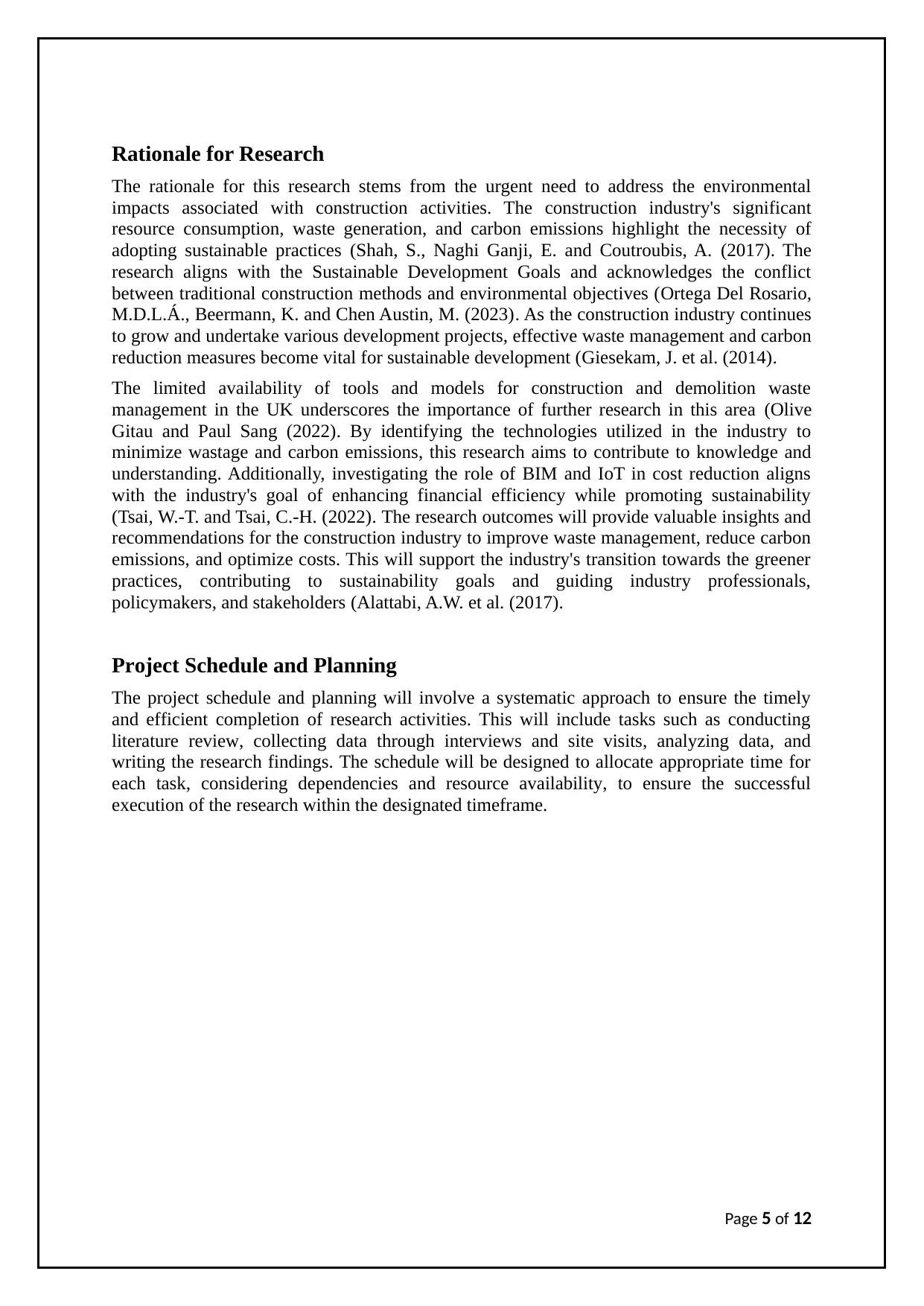
Rationale for Research
The rationale for this research stems from the urgent need to address the environmental
impacts associated with construction activities. The construction industry's significant
resource consumption, waste generation, and carbon emissions highlight the necessity of
adopting sustainable practices (Shah, S., Naghi Ganji, E. and Coutroubis, A. (2017). The
research aligns with the Sustainable Development Goals and acknowledges the conflict
between traditional construction methods and environmental objectives (Ortega Del Rosario,
M.D.L.Á., Beermann, K. and Chen Austin, M. (2023). As the construction industry continues
to grow and undertake various development projects, effective waste management and carbon
reduction measures become vital for sustainable development (Giesekam, J. et al. (2014).
The limited availability of tools and models for construction and demolition waste
management in the UK underscores the importance of further research in this area (Olive
Gitau and Paul Sang (2022). By identifying the technologies utilized in the industry to
minimize wastage and carbon emissions, this research aims to contribute to knowledge and
understanding. Additionally, investigating the role of BIM and IoT in cost reduction aligns
with the industry's goal of enhancing financial efficiency while promoting sustainability
(Tsai, W.-T. and Tsai, C.-H. (2022). The research outcomes will provide valuable insights and
recommendations for the construction industry to improve waste management, reduce carbon
emissions, and optimize costs. This will support the industry's transition towards the greener
practices, contributing to sustainability goals and guiding industry professionals,
policymakers, and stakeholders (Alattabi, A.W. et al. (2017).
Project Schedule and Planning
The project schedule and planning will involve a systematic approach to ensure the timely
and efficient completion of research activities. This will include tasks such as conducting
literature review, collecting data through interviews and site visits, analyzing data, and
writing the research findings. The schedule will be designed to allocate appropriate time for
each task, considering dependencies and resource availability, to ensure the successful
execution of the research within the designated timeframe.
Page 5 of 12
The rationale for this research stems from the urgent need to address the environmental
impacts associated with construction activities. The construction industry's significant
resource consumption, waste generation, and carbon emissions highlight the necessity of
adopting sustainable practices (Shah, S., Naghi Ganji, E. and Coutroubis, A. (2017). The
research aligns with the Sustainable Development Goals and acknowledges the conflict
between traditional construction methods and environmental objectives (Ortega Del Rosario,
M.D.L.Á., Beermann, K. and Chen Austin, M. (2023). As the construction industry continues
to grow and undertake various development projects, effective waste management and carbon
reduction measures become vital for sustainable development (Giesekam, J. et al. (2014).
The limited availability of tools and models for construction and demolition waste
management in the UK underscores the importance of further research in this area (Olive
Gitau and Paul Sang (2022). By identifying the technologies utilized in the industry to
minimize wastage and carbon emissions, this research aims to contribute to knowledge and
understanding. Additionally, investigating the role of BIM and IoT in cost reduction aligns
with the industry's goal of enhancing financial efficiency while promoting sustainability
(Tsai, W.-T. and Tsai, C.-H. (2022). The research outcomes will provide valuable insights and
recommendations for the construction industry to improve waste management, reduce carbon
emissions, and optimize costs. This will support the industry's transition towards the greener
practices, contributing to sustainability goals and guiding industry professionals,
policymakers, and stakeholders (Alattabi, A.W. et al. (2017).
Project Schedule and Planning
The project schedule and planning will involve a systematic approach to ensure the timely
and efficient completion of research activities. This will include tasks such as conducting
literature review, collecting data through interviews and site visits, analyzing data, and
writing the research findings. The schedule will be designed to allocate appropriate time for
each task, considering dependencies and resource availability, to ensure the successful
execution of the research within the designated timeframe.
Page 5 of 12
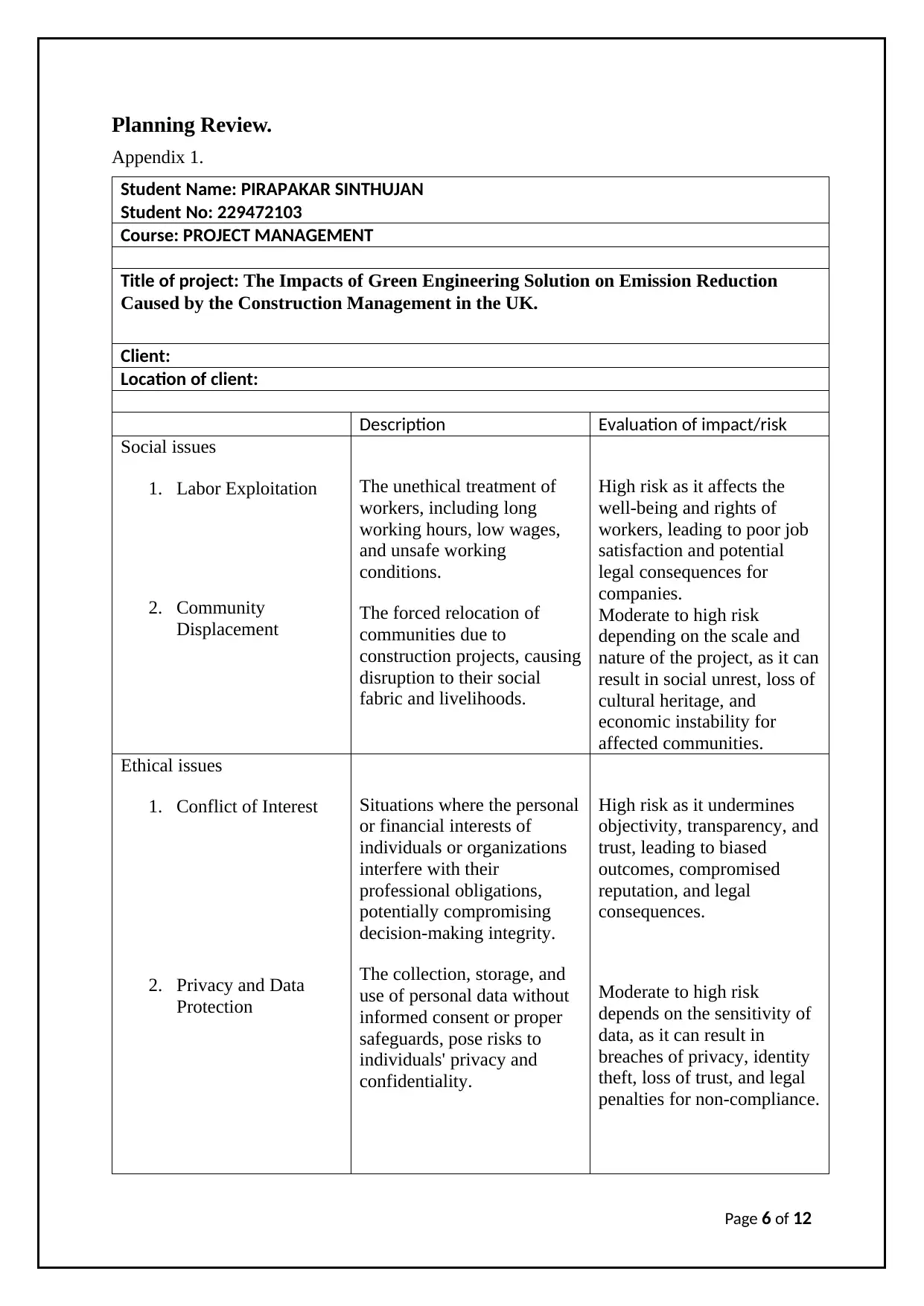
Planning Review.
Appendix 1.
Student Name: PIRAPAKAR SINTHUJAN
Student No: 229472103
Course: PROJECT MANAGEMENT
Title of project: The Impacts of Green Engineering Solution on Emission Reduction
Caused by the Construction Management in the UK.
Client:
Location of client:
Description Evaluation of impact/risk
Social issues
1. Labor Exploitation
2. Community
Displacement
The unethical treatment of
workers, including long
working hours, low wages,
and unsafe working
conditions.
The forced relocation of
communities due to
construction projects, causing
disruption to their social
fabric and livelihoods.
High risk as it affects the
well-being and rights of
workers, leading to poor job
satisfaction and potential
legal consequences for
companies.
Moderate to high risk
depending on the scale and
nature of the project, as it can
result in social unrest, loss of
cultural heritage, and
economic instability for
affected communities.
Ethical issues
1. Conflict of Interest
2. Privacy and Data
Protection
Situations where the personal
or financial interests of
individuals or organizations
interfere with their
professional obligations,
potentially compromising
decision-making integrity.
The collection, storage, and
use of personal data without
informed consent or proper
safeguards, pose risks to
individuals' privacy and
confidentiality.
High risk as it undermines
objectivity, transparency, and
trust, leading to biased
outcomes, compromised
reputation, and legal
consequences.
Moderate to high risk
depends on the sensitivity of
data, as it can result in
breaches of privacy, identity
theft, loss of trust, and legal
penalties for non-compliance.
Page 6 of 12
Appendix 1.
Student Name: PIRAPAKAR SINTHUJAN
Student No: 229472103
Course: PROJECT MANAGEMENT
Title of project: The Impacts of Green Engineering Solution on Emission Reduction
Caused by the Construction Management in the UK.
Client:
Location of client:
Description Evaluation of impact/risk
Social issues
1. Labor Exploitation
2. Community
Displacement
The unethical treatment of
workers, including long
working hours, low wages,
and unsafe working
conditions.
The forced relocation of
communities due to
construction projects, causing
disruption to their social
fabric and livelihoods.
High risk as it affects the
well-being and rights of
workers, leading to poor job
satisfaction and potential
legal consequences for
companies.
Moderate to high risk
depending on the scale and
nature of the project, as it can
result in social unrest, loss of
cultural heritage, and
economic instability for
affected communities.
Ethical issues
1. Conflict of Interest
2. Privacy and Data
Protection
Situations where the personal
or financial interests of
individuals or organizations
interfere with their
professional obligations,
potentially compromising
decision-making integrity.
The collection, storage, and
use of personal data without
informed consent or proper
safeguards, pose risks to
individuals' privacy and
confidentiality.
High risk as it undermines
objectivity, transparency, and
trust, leading to biased
outcomes, compromised
reputation, and legal
consequences.
Moderate to high risk
depends on the sensitivity of
data, as it can result in
breaches of privacy, identity
theft, loss of trust, and legal
penalties for non-compliance.
Page 6 of 12
⊘ This is a preview!⊘
Do you want full access?
Subscribe today to unlock all pages.

Trusted by 1+ million students worldwide
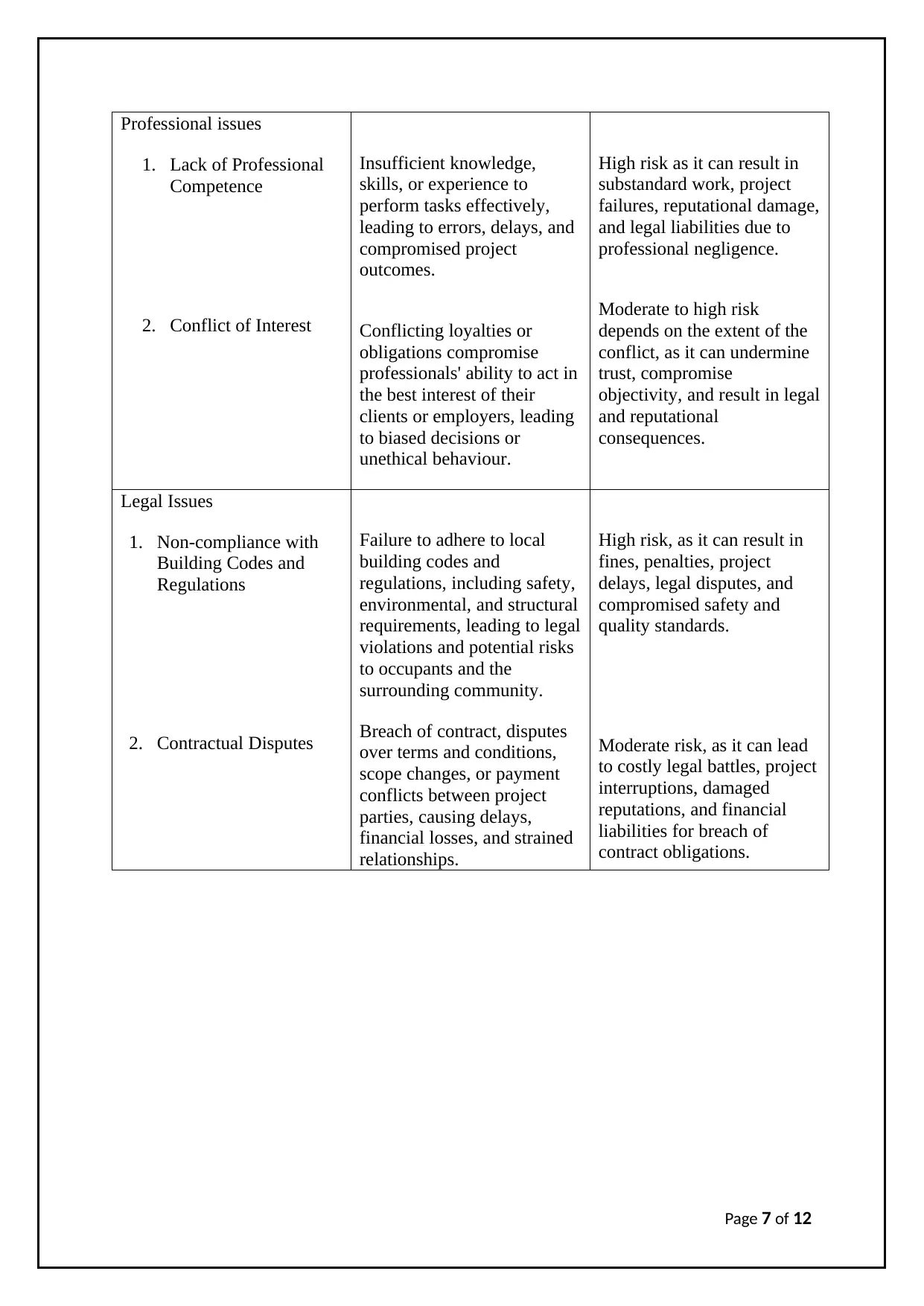
Professional issues
1. Lack of Professional
Competence
2. Conflict of Interest
Insufficient knowledge,
skills, or experience to
perform tasks effectively,
leading to errors, delays, and
compromised project
outcomes.
Conflicting loyalties or
obligations compromise
professionals' ability to act in
the best interest of their
clients or employers, leading
to biased decisions or
unethical behaviour.
High risk as it can result in
substandard work, project
failures, reputational damage,
and legal liabilities due to
professional negligence.
Moderate to high risk
depends on the extent of the
conflict, as it can undermine
trust, compromise
objectivity, and result in legal
and reputational
consequences.
Legal Issues
1. Non-compliance with
Building Codes and
Regulations
2. Contractual Disputes
Failure to adhere to local
building codes and
regulations, including safety,
environmental, and structural
requirements, leading to legal
violations and potential risks
to occupants and the
surrounding community.
Breach of contract, disputes
over terms and conditions,
scope changes, or payment
conflicts between project
parties, causing delays,
financial losses, and strained
relationships.
High risk, as it can result in
fines, penalties, project
delays, legal disputes, and
compromised safety and
quality standards.
Moderate risk, as it can lead
to costly legal battles, project
interruptions, damaged
reputations, and financial
liabilities for breach of
contract obligations.
Page 7 of 12
1. Lack of Professional
Competence
2. Conflict of Interest
Insufficient knowledge,
skills, or experience to
perform tasks effectively,
leading to errors, delays, and
compromised project
outcomes.
Conflicting loyalties or
obligations compromise
professionals' ability to act in
the best interest of their
clients or employers, leading
to biased decisions or
unethical behaviour.
High risk as it can result in
substandard work, project
failures, reputational damage,
and legal liabilities due to
professional negligence.
Moderate to high risk
depends on the extent of the
conflict, as it can undermine
trust, compromise
objectivity, and result in legal
and reputational
consequences.
Legal Issues
1. Non-compliance with
Building Codes and
Regulations
2. Contractual Disputes
Failure to adhere to local
building codes and
regulations, including safety,
environmental, and structural
requirements, leading to legal
violations and potential risks
to occupants and the
surrounding community.
Breach of contract, disputes
over terms and conditions,
scope changes, or payment
conflicts between project
parties, causing delays,
financial losses, and strained
relationships.
High risk, as it can result in
fines, penalties, project
delays, legal disputes, and
compromised safety and
quality standards.
Moderate risk, as it can lead
to costly legal battles, project
interruptions, damaged
reputations, and financial
liabilities for breach of
contract obligations.
Page 7 of 12
Paraphrase This Document
Need a fresh take? Get an instant paraphrase of this document with our AI Paraphraser
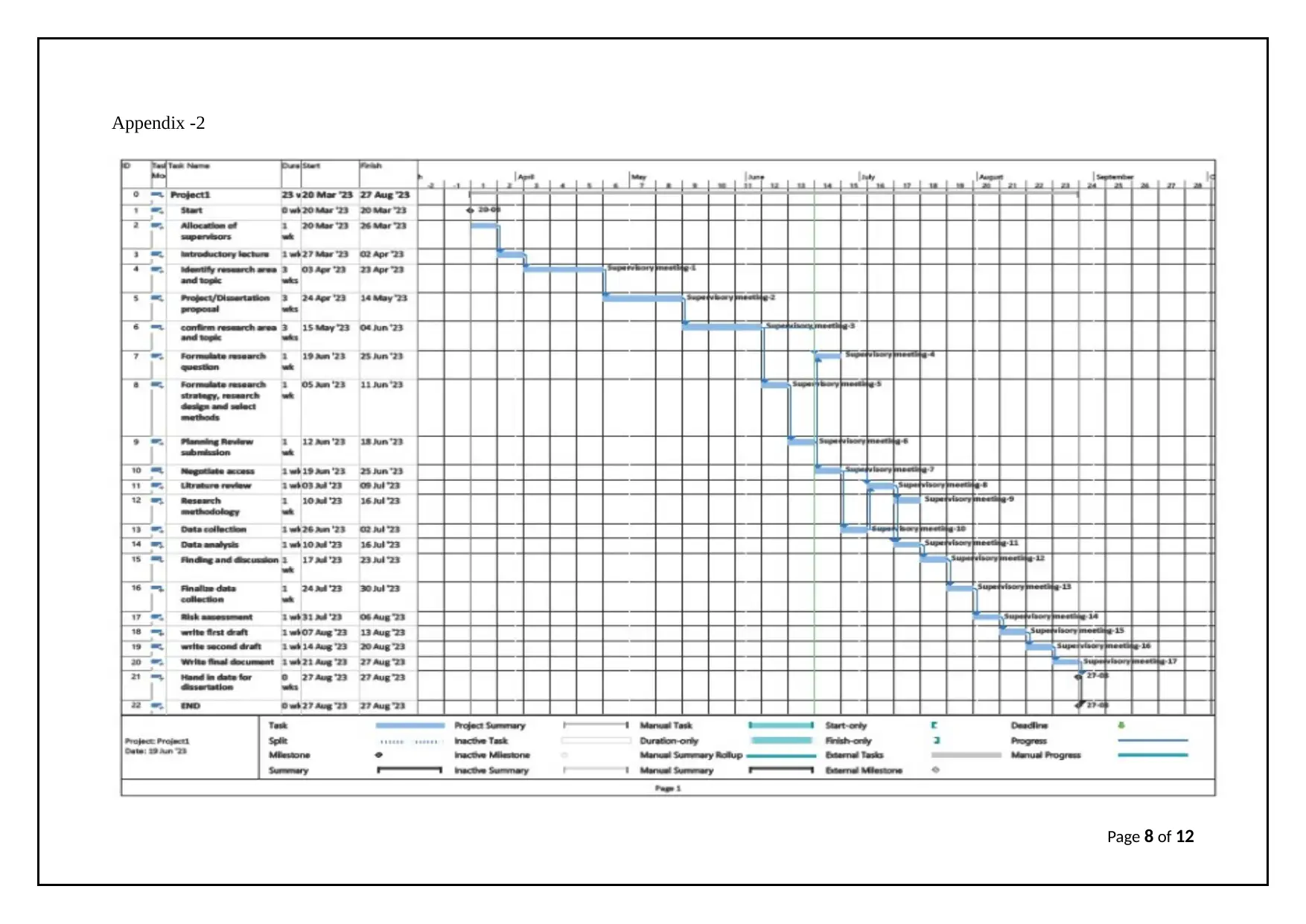
Appendix -2
Page 8 of 12
Page 8 of 12
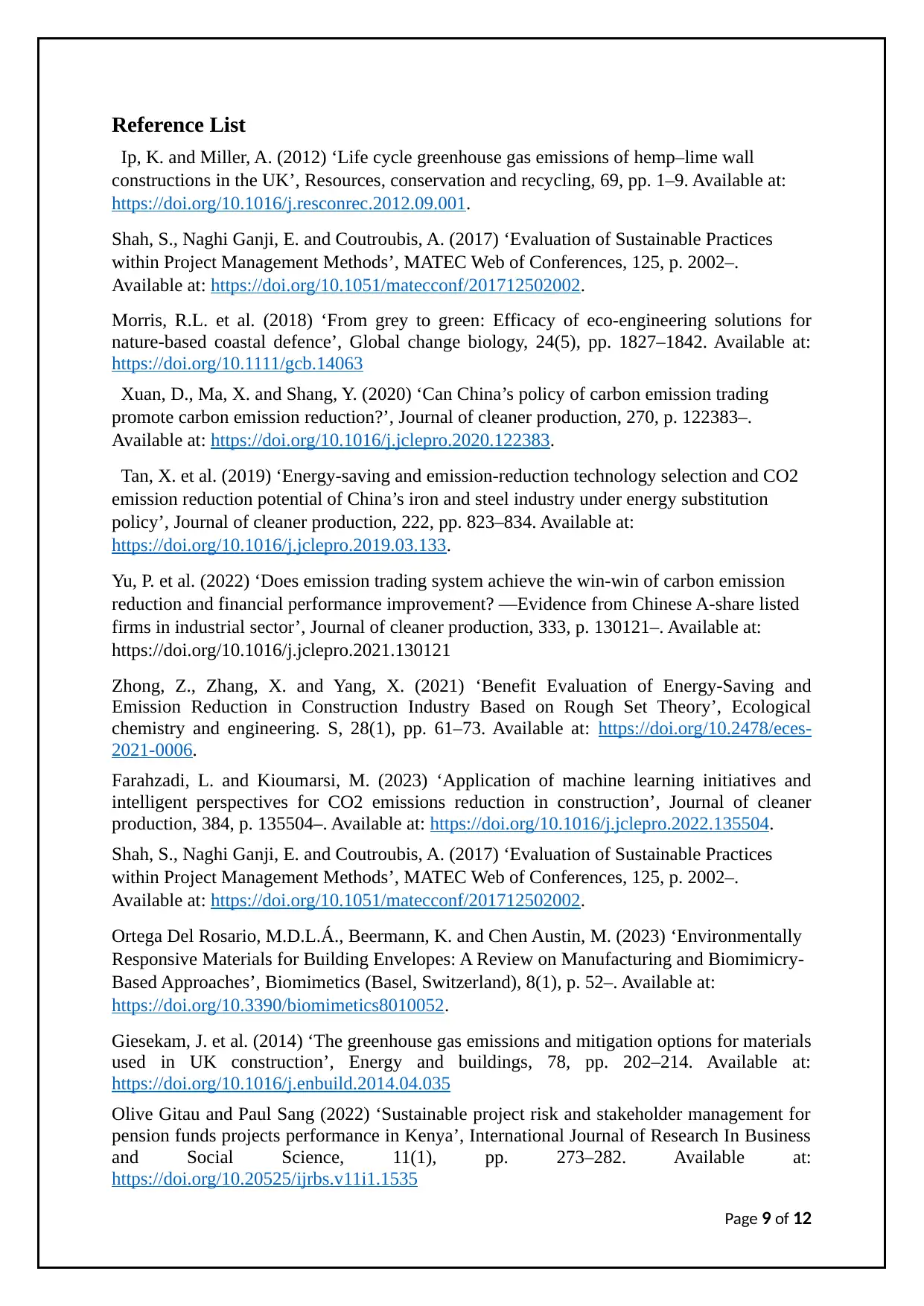
Reference List
Ip, K. and Miller, A. (2012) ‘Life cycle greenhouse gas emissions of hemp–lime wall
constructions in the UK’, Resources, conservation and recycling, 69, pp. 1–9. Available at:
https://doi.org/10.1016/j.resconrec.2012.09.001.
Shah, S., Naghi Ganji, E. and Coutroubis, A. (2017) ‘Evaluation of Sustainable Practices
within Project Management Methods’, MATEC Web of Conferences, 125, p. 2002–.
Available at: https://doi.org/10.1051/matecconf/201712502002.
Morris, R.L. et al. (2018) ‘From grey to green: Efficacy of eco‐engineering solutions for
nature‐based coastal defence’, Global change biology, 24(5), pp. 1827–1842. Available at:
https://doi.org/10.1111/gcb.14063
Xuan, D., Ma, X. and Shang, Y. (2020) ‘Can China’s policy of carbon emission trading
promote carbon emission reduction?’, Journal of cleaner production, 270, p. 122383–.
Available at: https://doi.org/10.1016/j.jclepro.2020.122383.
Tan, X. et al. (2019) ‘Energy-saving and emission-reduction technology selection and CO2
emission reduction potential of China’s iron and steel industry under energy substitution
policy’, Journal of cleaner production, 222, pp. 823–834. Available at:
https://doi.org/10.1016/j.jclepro.2019.03.133.
Yu, P. et al. (2022) ‘Does emission trading system achieve the win-win of carbon emission
reduction and financial performance improvement? —Evidence from Chinese A-share listed
firms in industrial sector’, Journal of cleaner production, 333, p. 130121–. Available at:
https://doi.org/10.1016/j.jclepro.2021.130121
Zhong, Z., Zhang, X. and Yang, X. (2021) ‘Benefit Evaluation of Energy-Saving and
Emission Reduction in Construction Industry Based on Rough Set Theory’, Ecological
chemistry and engineering. S, 28(1), pp. 61–73. Available at: https://doi.org/10.2478/eces-
2021-0006.
Farahzadi, L. and Kioumarsi, M. (2023) ‘Application of machine learning initiatives and
intelligent perspectives for CO2 emissions reduction in construction’, Journal of cleaner
production, 384, p. 135504–. Available at: https://doi.org/10.1016/j.jclepro.2022.135504.
Shah, S., Naghi Ganji, E. and Coutroubis, A. (2017) ‘Evaluation of Sustainable Practices
within Project Management Methods’, MATEC Web of Conferences, 125, p. 2002–.
Available at: https://doi.org/10.1051/matecconf/201712502002.
Ortega Del Rosario, M.D.L.Á., Beermann, K. and Chen Austin, M. (2023) ‘Environmentally
Responsive Materials for Building Envelopes: A Review on Manufacturing and Biomimicry-
Based Approaches’, Biomimetics (Basel, Switzerland), 8(1), p. 52–. Available at:
https://doi.org/10.3390/biomimetics8010052.
Giesekam, J. et al. (2014) ‘The greenhouse gas emissions and mitigation options for materials
used in UK construction’, Energy and buildings, 78, pp. 202–214. Available at:
https://doi.org/10.1016/j.enbuild.2014.04.035
Olive Gitau and Paul Sang (2022) ‘Sustainable project risk and stakeholder management for
pension funds projects performance in Kenya’, International Journal of Research In Business
and Social Science, 11(1), pp. 273–282. Available at:
https://doi.org/10.20525/ijrbs.v11i1.1535
Page 9 of 12
Ip, K. and Miller, A. (2012) ‘Life cycle greenhouse gas emissions of hemp–lime wall
constructions in the UK’, Resources, conservation and recycling, 69, pp. 1–9. Available at:
https://doi.org/10.1016/j.resconrec.2012.09.001.
Shah, S., Naghi Ganji, E. and Coutroubis, A. (2017) ‘Evaluation of Sustainable Practices
within Project Management Methods’, MATEC Web of Conferences, 125, p. 2002–.
Available at: https://doi.org/10.1051/matecconf/201712502002.
Morris, R.L. et al. (2018) ‘From grey to green: Efficacy of eco‐engineering solutions for
nature‐based coastal defence’, Global change biology, 24(5), pp. 1827–1842. Available at:
https://doi.org/10.1111/gcb.14063
Xuan, D., Ma, X. and Shang, Y. (2020) ‘Can China’s policy of carbon emission trading
promote carbon emission reduction?’, Journal of cleaner production, 270, p. 122383–.
Available at: https://doi.org/10.1016/j.jclepro.2020.122383.
Tan, X. et al. (2019) ‘Energy-saving and emission-reduction technology selection and CO2
emission reduction potential of China’s iron and steel industry under energy substitution
policy’, Journal of cleaner production, 222, pp. 823–834. Available at:
https://doi.org/10.1016/j.jclepro.2019.03.133.
Yu, P. et al. (2022) ‘Does emission trading system achieve the win-win of carbon emission
reduction and financial performance improvement? —Evidence from Chinese A-share listed
firms in industrial sector’, Journal of cleaner production, 333, p. 130121–. Available at:
https://doi.org/10.1016/j.jclepro.2021.130121
Zhong, Z., Zhang, X. and Yang, X. (2021) ‘Benefit Evaluation of Energy-Saving and
Emission Reduction in Construction Industry Based on Rough Set Theory’, Ecological
chemistry and engineering. S, 28(1), pp. 61–73. Available at: https://doi.org/10.2478/eces-
2021-0006.
Farahzadi, L. and Kioumarsi, M. (2023) ‘Application of machine learning initiatives and
intelligent perspectives for CO2 emissions reduction in construction’, Journal of cleaner
production, 384, p. 135504–. Available at: https://doi.org/10.1016/j.jclepro.2022.135504.
Shah, S., Naghi Ganji, E. and Coutroubis, A. (2017) ‘Evaluation of Sustainable Practices
within Project Management Methods’, MATEC Web of Conferences, 125, p. 2002–.
Available at: https://doi.org/10.1051/matecconf/201712502002.
Ortega Del Rosario, M.D.L.Á., Beermann, K. and Chen Austin, M. (2023) ‘Environmentally
Responsive Materials for Building Envelopes: A Review on Manufacturing and Biomimicry-
Based Approaches’, Biomimetics (Basel, Switzerland), 8(1), p. 52–. Available at:
https://doi.org/10.3390/biomimetics8010052.
Giesekam, J. et al. (2014) ‘The greenhouse gas emissions and mitigation options for materials
used in UK construction’, Energy and buildings, 78, pp. 202–214. Available at:
https://doi.org/10.1016/j.enbuild.2014.04.035
Olive Gitau and Paul Sang (2022) ‘Sustainable project risk and stakeholder management for
pension funds projects performance in Kenya’, International Journal of Research In Business
and Social Science, 11(1), pp. 273–282. Available at:
https://doi.org/10.20525/ijrbs.v11i1.1535
Page 9 of 12
⊘ This is a preview!⊘
Do you want full access?
Subscribe today to unlock all pages.

Trusted by 1+ million students worldwide
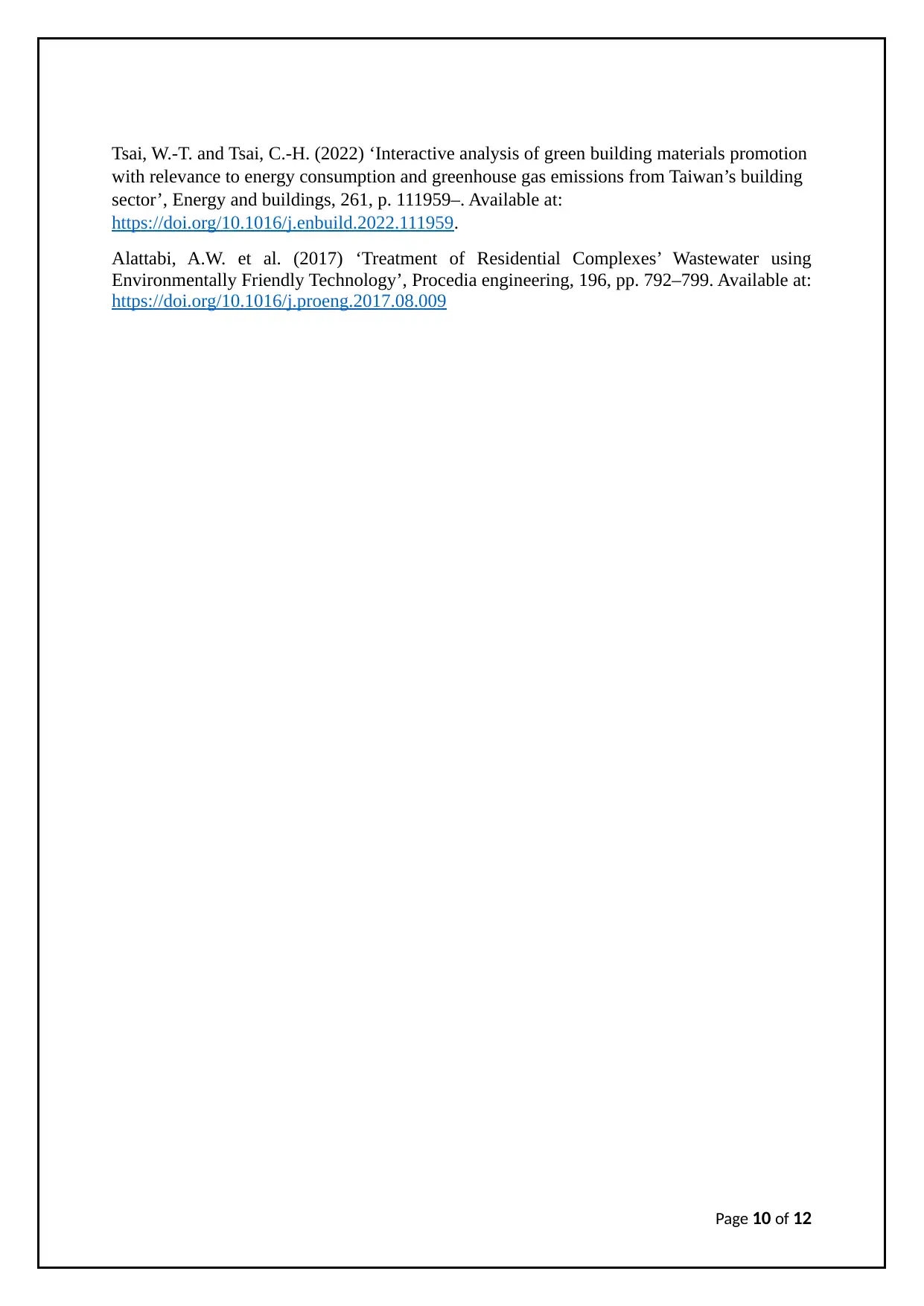
Tsai, W.-T. and Tsai, C.-H. (2022) ‘Interactive analysis of green building materials promotion
with relevance to energy consumption and greenhouse gas emissions from Taiwan’s building
sector’, Energy and buildings, 261, p. 111959–. Available at:
https://doi.org/10.1016/j.enbuild.2022.111959.
Alattabi, A.W. et al. (2017) ‘Treatment of Residential Complexes’ Wastewater using
Environmentally Friendly Technology’, Procedia engineering, 196, pp. 792–799. Available at:
https://doi.org/10.1016/j.proeng.2017.08.009
Page 10 of 12
with relevance to energy consumption and greenhouse gas emissions from Taiwan’s building
sector’, Energy and buildings, 261, p. 111959–. Available at:
https://doi.org/10.1016/j.enbuild.2022.111959.
Alattabi, A.W. et al. (2017) ‘Treatment of Residential Complexes’ Wastewater using
Environmentally Friendly Technology’, Procedia engineering, 196, pp. 792–799. Available at:
https://doi.org/10.1016/j.proeng.2017.08.009
Page 10 of 12
Paraphrase This Document
Need a fresh take? Get an instant paraphrase of this document with our AI Paraphraser

Page 11 of 12

Page 12 of 12
⊘ This is a preview!⊘
Do you want full access?
Subscribe today to unlock all pages.

Trusted by 1+ million students worldwide
1 out of 12
Related Documents
Your All-in-One AI-Powered Toolkit for Academic Success.
+13062052269
info@desklib.com
Available 24*7 on WhatsApp / Email
![[object Object]](/_next/static/media/star-bottom.7253800d.svg)
Unlock your academic potential
© 2024 | Zucol Services PVT LTD | All rights reserved.





